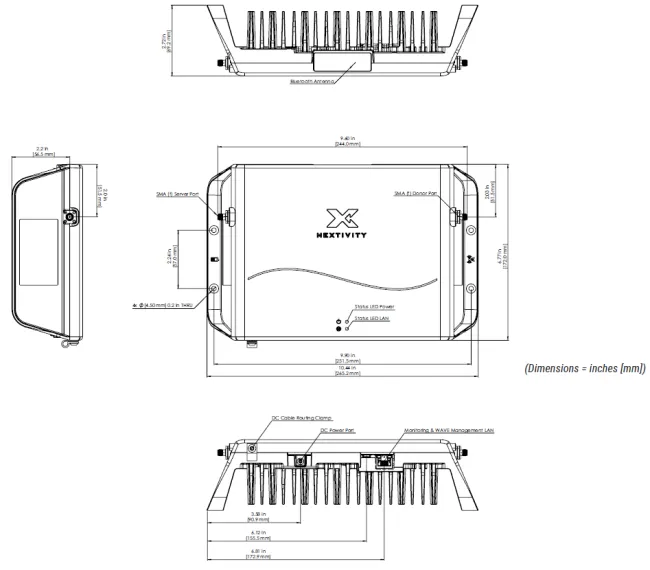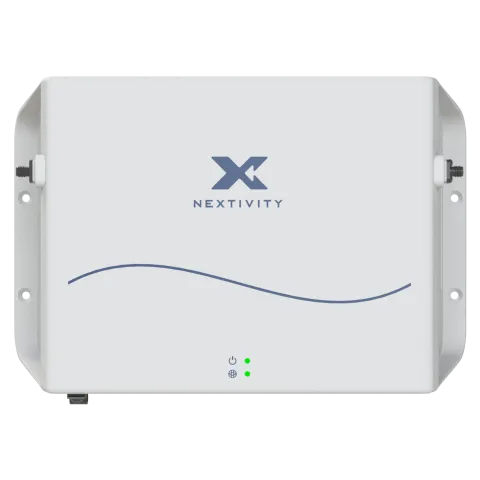Description
Following the technological evolution of the Cel-Fi G41, the G51 is next in the series, providing all the brilliance of the G41 with the addition of mid-band 5G. G51 automatically scans and boosts the entire channel width of 5G 3500 MHz, which is the major global 5G band known as n78, along with boosting a 4G band to provide long range connectivity.
G51 is essential for any tech professional, enterprise, or industrial environment looking to leverage the low latency and ultra-fast data performance that 5G brings. Unlike complicated "Private 5G" networks or DAS which can take 6-12 months to implement, G51 can be installed in as little as a few hours. The unit identifies and locks on to the network operator's 5G network, and can be connected to one or many antennas distributed throughout the building to provide seamless, strong voice and data connectivity.
Cel-Fi G51 is a very straight forward device, it has a single input RF connector which connects to a roof-mounted (donor) antenna, and a single output RF connector which connects to an indoor (service) antenna. Powertec provide a range of 5G-compatible antennas that have been laboratory verified for best performance on n78 5G.
The output power of G51 is +20 dBm for most bands. It's important to be mindful that while the stated output power for n78 is +27 dBm, the larger 100 MHz channel width (up to 5x wider than 4G) means that more power is required to lift the channel to the same level of output power (per MHz) as its 4G channels, rather than being used to deliver a larger coverage footprint.
RF Specification
Supported Bands
| Frequency Band | Duplex Method | MIMO | Downlink Output Power | Uplink Output Power | Max. Channel Width | Downlink Start Frequency | Downlink Stop Frequency | Uplink Start Frequency | Uplink Stop Frequency |
|---|---|---|---|---|---|---|---|---|---|
|
20 dBm
|
22 dBm
|
20 MHz
|
2110 MHz
|
2170 MHz
|
1920 MHz
|
1980 MHz
|
|||
|
20 dBm
|
22 dBm
|
20 MHz
|
1805 MHz
|
1880 MHz
|
1710 MHz
|
1785 MHz
|
|||
|
20 dBm
|
20 dBm
|
20 MHz
|
869 MHz
|
894 MHz
|
824 MHz
|
849 MHz
|
|||
|
20 dBm
|
22 dBm
|
20 MHz
|
2620 MHz
|
2690 MHz
|
2500 MHz
|
2570 MHz
|
|||
|
20 dBm
|
20 dBm
|
15 MHz
|
925 MHz
|
960 MHz
|
880 MHz
|
915 MHz
|
|||
|
20 dBm
|
20 dBm
|
20 MHz
|
791 MHz
|
821 MHz
|
832 MHz
|
862 MHz
|
|||
|
20 dBm
|
20 dBm
|
20 MHz
|
758 MHz
|
788 MHz
|
703 MHz
|
733 MHz
|
|||
|
27 dBm
|
24 dBm
|
100 MHz
|
3300 MHz
|
3800 MHz
|
3300 MHz
|
3800 MHz
|
RF Connections
| RF Connector Function | Quantity | RF Interface | Notes |
|---|---|---|---|
|
Donor Input
|
1
|
||
|
Service Output
|
1
|
Network Interfaces
Wireless Interfaces
Ethernet Interfaces
| Interface | Quantity | Function | Signalling |
|---|---|---|---|
|
1
|
Management
|
Physical Specification
Device Power Specifications
Power Interface
| Power Connector | Min. Input Voltage | Max. Input Voltage | Voltage Type | Input Current |
|---|---|---|---|---|
|
DC Coaxial, Type A, Female 5.5 x 2.5 mm
|
9 V
|
13 V
|
DC
|
2.5 A
|
Drawing

Downloadable Resources
Nextivity, Inc. develops and sells in-building cellular coverage technology products and solutions. The Company helps wireless subscribers and increases radio frequency network capacity for mobile network operators. Nextivity operates in the State of California.
Nextivity is best known for its Cel-Fi range of mobile repeater solutions which provide low cost improved in-building coverage solutions.

